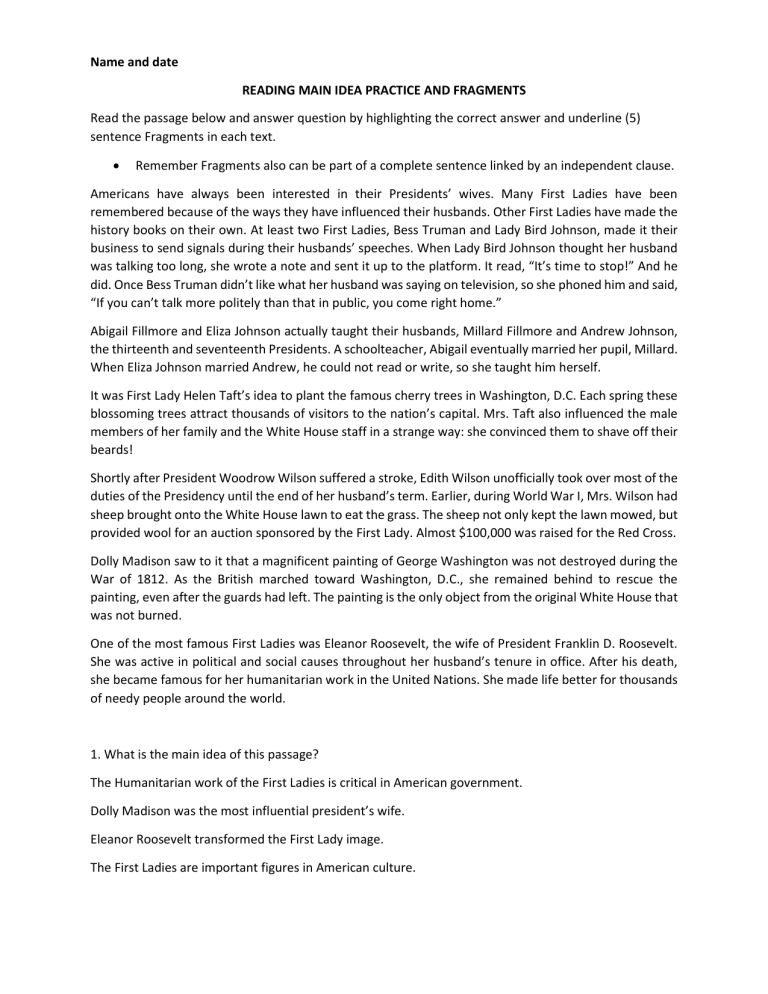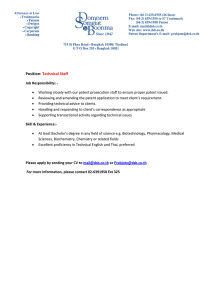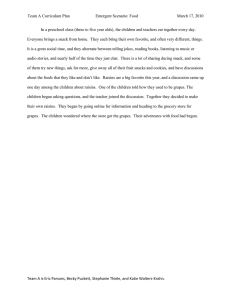
Name and date READING MAIN IDEA PRACTICE AND FRAGMENTS Read the passage below and answer question by highlighting the correct answer and underline (5) sentence Fragments in each text. Remember Fragments also can be part of a complete sentence linked by an independent clause. Americans have always been interested in their Presidents’ wives. Many First Ladies have been remembered because of the ways they have influenced their husbands. Other First Ladies have made the history books on their own. At least two First Ladies, Bess Truman and Lady Bird Johnson, made it their business to send signals during their husbands’ speeches. When Lady Bird Johnson thought her husband was talking too long, she wrote a note and sent it up to the platform. It read, “It’s time to stop!” And he did. Once Bess Truman didn’t like what her husband was saying on television, so she phoned him and said, “If you can’t talk more politely than that in public, you come right home.” Abigail Fillmore and Eliza Johnson actually taught their husbands, Millard Fillmore and Andrew Johnson, the thirteenth and seventeenth Presidents. A schoolteacher, Abigail eventually married her pupil, Millard. When Eliza Johnson married Andrew, he could not read or write, so she taught him herself. It was First Lady Helen Taft’s idea to plant the famous cherry trees in Washington, D.C. Each spring these blossoming trees attract thousands of visitors to the nation’s capital. Mrs. Taft also influenced the male members of her family and the White House staff in a strange way: she convinced them to shave off their beards! Shortly after President Woodrow Wilson suffered a stroke, Edith Wilson unofficially took over most of the duties of the Presidency until the end of her husband’s term. Earlier, during World War I, Mrs. Wilson had sheep brought onto the White House lawn to eat the grass. The sheep not only kept the lawn mowed, but provided wool for an auction sponsored by the First Lady. Almost $100,000 was raised for the Red Cross. Dolly Madison saw to it that a magnificent painting of George Washington was not destroyed during the War of 1812. As the British marched toward Washington, D.C., she remained behind to rescue the painting, even after the guards had left. The painting is the only object from the original White House that was not burned. One of the most famous First Ladies was Eleanor Roosevelt, the wife of President Franklin D. Roosevelt. She was active in political and social causes throughout her husband’s tenure in office. After his death, she became famous for her humanitarian work in the United Nations. She made life better for thousands of needy people around the world. 1. What is the main idea of this passage? The Humanitarian work of the First Ladies is critical in American government. Dolly Madison was the most influential president’s wife. Eleanor Roosevelt transformed the First Lady image. The First Ladies are important figures in American culture. The First Ladies are key supporters of the Presidents. Read the passage below and answer question 2. Of the many kinds of vegetables grown all over the world, which remains the favorite of young and old alike? The potato, of course. Perhaps you know them as “taters,” “spuds,” or “Kennebees,” or as “chips,” “Idahoes,” or even “shoestrings.” No matter, a potato by any other name is still a potato- the world’s most widely grown vegetable. As a matter of fact, if you are an average potato eater, you will put away at least 100 pounds of them each year. That’s only a tiny portion of the amount grown every year, however. Worldwide, the annual potato harvest is over 6 billion bags. Each bag contains 100 pounds of potatoes, some of them as large as four pounds each. Here in the United States, farmers fill about 400 million bags a year. That may seem like a lot of “taters,” but it leaves the United States a distant third among world potato growers. Polish farmers dig up just over 800 million bags a year, while the Russians lead the world with nearly 1.5 billion bags. The first potatoes were grown by the Incas of South America, more than 400 years ago. Their descendants in Ecuador and Chile continue to grow the vegetable as high as 14,000 feet up in the Andes Mountains. (That’s higher than any other food will grow.) Early Spanish and English explorers shipped potatoes to Europe, and they found their way to North America in the early 1600s. People eat potatoes in many ways-baked, mashed, and roasted, to name just three. However, in the United States most potatoes are devoured in the form of French fries. One fast-food chain alone sells more than $1 billion worth of fries each year. No wonder, then, that the company pays particular attention to the way its fries are prepared. Before any fry makes it to the people who eat at these popular restaurants, it must pass many separate tests. Fail any one of these tests and the potato is rejected. To start with, only Russet Burbank potatoes are used. These Idaho potatoes have less water content than other kinds, which can have as much as 80 percent water. Once cut into “shoestrings” shapes, the potatoes are partly fried in a secret blend of oils, sprayed with liquid sugar to brown them, steam dried at high heat, then flash frozen for shipment to individual restaurants. Before shipping, every shoestring is measured. Forty percent of a batch must be between two and three inches long. Another 40 percent has to be over three inches. What about the 20 percent that are left in the batch? Well, a few short fries in a bag are okay, it seems. So, now that you realize the enormous size and value of the potato crop, you can understand why most people agree that this part of the food industry is no “small potatoes.” 2. What is the main idea of this passage? Potatoes from Ireland started the Potato Revolution. The average American eats 50 pounds of potatoes a year. French fries are made from potatoes. Potatoes are a key vegetable in America. The various terms for potatoes have a long history. Read the passage below and answer question 3. What does the word “patent” mean to you? Does it strike you as being something rather remote from your interests? If it does, stop and think a moment about some of the commonplace things that you use every day, those objects that you take for granted as part of the world around you. The telephone, radio, television, automobile, and the 1,001 other things (even the humble safety pin) that enrich our lives today once existed only as ideas in the minds of men. If it had not been possible to patent their ideas and thus protect them against copying by others, these inventions might never have been fully developed to serve mankind. If there were no patent protection there would be little incentive to invent and innovate, for once the details of an invention became known, hordes of imitators who did not share the inventor’s risks and expenses might well flood the market with their copies of his product and reap much of the benefit of his efforts. The technological progress that has made America great would wither rapidly under conditions such as these. The fundamental principles in the United States patent structure came from England. During the glorious reign of Queen Elizabeth I in England, the expanding technology was furthered by the granting of exclusive manufacturing and selling privileges to citizens who had invented new processes or tools-a step that did much to encourage creativity. Later, when critics argued that giving monopoly rights to one person infringed on the rights of others, an important principle was added to the patent structure: The Lord Chief Justice of England stated that society had everything to gain and nothing to lose by granting exclusive privileges to an inventor, because a patent for an invention was granted for something new that society never had before. Another basic principle was brought into law because certain influential people in England had managed to obtain monopoly control over such age-old products as salt, and had begun charging as much as the people could tolerate. The public outcry became so great that the government was forced to decree that monopoly rights could be awarded only to those who created or introduced something really unique. These principles are the mainstays of the modern patent system in the United States. In colonial times, patent law was left up to the separate states. The inconsistency, confusion, and unfairness that resulted clearly indicated the need for a uniform patent law, and the men who drew up the Constitution incorporated one. George Washington signed the first patent law on April 10, 1790, and less than four months later the first patent was issued to a man named Samuel Hopkins for a chemical process, an improved method of making potash for use in soapmaking. In 1936 the Patent Office was established as a separate bureau. From the staff of eight that it maintained during its first year of operation, it has grown into an organization of over 2,500 people handling more than 1,600 patent applications and granting over 1,000 every week. The Patent Office in Washington, D.C. is the world’s largest library of scientific and technical data, and this treasure trove of information is open for public inspection. In addition to more than 3 million US patents, it houses more than 7 million foreign patents and thousands of volumes of technical literature. Abraham Lincoln patented a device to lift steam vessels over river shoals, Mark Twain developed a self-pasting scrapbook, and millionaire Cornelius Vanderbilt invented a shoe-shine kit. A patent may be granted for any new and useful process, machine, article of manufacture, or composition of matter (a chemical compound or combinations of chemical compounds), or any distinct and new variety of plant, including certain mutants and hybrids. The patent system has also helped to boost the wages of the American worker to an unprecedented level: he can produce more and earn more with the computer, adding machines, drill press or lathe. Patented inventions also help keep prices down by increasing manufacturing efficiency and by stimulating the competition that is the foundation of our free enterprise system. The decades of history have disclosed little need for modification of the patent structure. United States patent laws, like the Constitution from which they grew, have stood the test of time well. They encouraged the creative processes, brought untold benefits to society as a whole, and enabled American technology to outstrip that of the rest of the civilized world. 3. What is the main idea of this passage? The patent system encourages free enterprise. The Constitution protects the patent system. The patent system in England has been influential in American patent development. Patents are important tools for inventors. Patented inventions protect the inventor, free enterprise, and the creative process. Read the passage below and answer question 4. Most people think that it’s fine to be “busy as a beaver.” Little do they know. Beavers may work hard, but often they don’t get very much done. Beavers are supposed to be great tree cutters. It is true that a beaver can gnaw through a tree very quickly: A six-inch birch takes about 10 minutes. But then what? Often the beaver does not make use of the tree. One expert says that beavers waste one out of every five trees they cut. For one thing, they do not choose their trees wisely. One bunch of beavers cut down a cottonwood tree more than 100 feet tall. Then they found that they could not move it. In thick woods, a tree sometimes won’t fall down. It gets stuck in the other trees. Of course, the beaver doesn’t think to cut down the trees that are in the way. So a good tree goes to waste. Some people think that beavers can make a tree fall the way they want it to. Not true. (In fact, beavers sometimes get pinned under a falling tree.) When beavers cut a tree near a stream, it usually falls into the water, but they do not plan it that way. The fact is that most trees lean toward the water to start with. Now what about dam building? Most beaver dams are wonders of engineering. The best ones are strongly built of trees, stones, and mud. They are wide at the bottom and narrow at the top. Beavers think nothing of building a dam more than 200 feet long. One dam in Montana was more than 2,000 feet long. The largest one ever seen was in New Hampshire: it stretched 4,000 feet, and made a lake large enough to hold 40 beaver homes. So, beavers do build good dams. But they don’t always build them in the right places. They just don’t plan. They will build a dam across the widest part of the stream. They don’t try to find a place where the stream is narrow. So, a lot of their hard work is wasted. Beavers should learn that it’s not enough to be busy. You have to know what you’re doing, too. For example, there was one Oregon beaver that really was a worker. It decided to fix a leak in a man-made dam. After five days of work, it gave up. The leak it was trying to block was the lock that boats go through. 4. What is the main idea of this passage? Beavers may be hard-working animals, but they don’t always choose the most efficient mechanisms. Beavers are excellent dam builders. New Hampshire was the site of the largest beaver dam. Beavers are well-developed tree cutters. Beavers are poor surveyors of aquatic environments in some cases. Read the passage below and answer question 5. The raisin business in America was born by accident. It happened in 1873 in the San Joaquin Valley of California. Many farmers raised grapes in this valley. That year, just before the grape harvest, there was a heat wave. It was one of the worst heat waves ever known. It was so hot that the grapes dried on the vines. When they were picked, California had its first raisin crop. People were surprised to find how good raisins were. Everybody wanted more. So the San Joaquin farmers went into the raisin business. Today, of course, they do not let the grapes dry on the vines. They treat them with much more care. In late August the grapes start to ripen. They are tested often for sweetness. The growers wait until the sugar content is twenty-one percent. Then they know the grapes are ripe enough to be picked. Skilled workers come to the vineyards. They pick the grapes by hand in bunches. The workers fill their flat pans with grapes. They gently empty the pans onto squares of paper. These squares lie between the long rows of vines. They sit in the sun. Here the grapes stay while the sun does its work. It may take two weeks or longer. The grapes are first dried on one side. When they have reached the right color, they are turned to dry on the other side. The grapes are dried until only fifteen percent of the moisture is left. Then they have turned into raisins. The raisins are rolled up in the paper on which they have dried. Trucks take them from the fields. They are poured into big boxes called sweatboxes. Each box holds 160 pounds of raisins. Here, any raisins that are too dry take moisture from those that have too much. After a while, they are all just moist enough. The big boxes are trucked next to the packaging plant. They are emptied onto a conveyor belt that shakes the raisins gently. This knocks them from their stems. A blast of air whisks the stems away. The water bath is next. Then the plump brown raisins have a last inspection. They are again checked for moisture and sugar. Then they go on a belt to packing machines. Here they are poured into packages, which are automatically weighed and sealed. The raisins are now ready for market. 5. What is the main idea of this passage? The creation of raisins in America was an accident. The process of raisin development requires multiple steps. Raisins on the grocery store shelf undergo a brief fermentation process. Raisins are cleaned thoroughly at the packing plant. California has been the leader in American raisin development.


